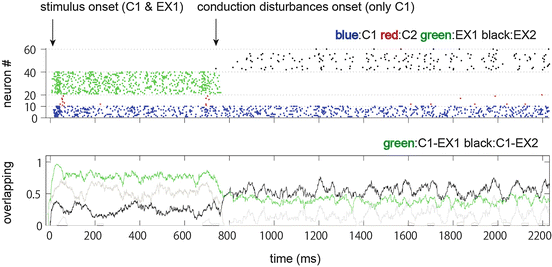Fig. 1
A schematic diagram of PFC network architecture
In the following, the two streams from Pathways II and III are considered as a single context-expectancy variable (the “top-down” stream), and the external image (the “bottom-up” stream) for simplicity. Thus the representation in the index space would be expressed by a concatenation [EXm, Cn], (m = 1,..,M; n = 1,..,N), where EXm and Cn, are respectively the m-th external image and the n-th context-expectancy expressed by a simple pattern of 0 and 1 binary sequences. (M = 2, N = 2 for the simplest case). The model is designed so that each concatenated vector [EXm, Cn] defines an attractor in the index space (see Fig. 1). This index network is tuned so that it exhibits a dynamics spontaneously itinerant among those (“quasi”) attractors [9] in default states, i.e., with no inputs.
The question is, if only a top-down “variable” (e.g., C1) is assigned (with no information on EX’s), then how would PFC behave? Possible states would be [C1, EX1] or [C1, EX2], both being C1 internal context-related. In fact, under such a situation, the index dynamics exhibits a transitory behavior among these C1-related states. That is, the network organizes a context-dependent itinerancy under such conditions. The staying time in a particular attractor would depend on the situation (see Fig. 2).


Fig. 2
Effect of conduction disturbances. (Top) Spike rasterplot of pyramidal neurons in the PFC network. Different colors indicate a different cell assembly (blue: C1; red: C2; green: EX1; black: EX2). (Bottom) Overlapping between spike patterns of neurons in the PFC network and stored attractor patterns
2.2 IT Model
The IT network receives a “categorical index” from the PFC, and this biasing signal could activate the object representation even without inputs from the visual cortices [10, 11]. This is the situation that we postulate as the one that occur in DLB hallucinators. We emphasize that IT neurons are activated by top-down signals without bottom-up sensory input [10]. Moreover, attentional biasing signals can also be generated in the absence of any visual stimulation whatsoever [11]. The basic question is how the IT can activate a relevant object representation solely from a top-down index from the PFC. We propose the following two scenarios.
Scenario I. Attentional Phasic Cholinergic Projections onto the IT
Phasic (transient) acetylcholine (ACh) projections from the nucleus basalis of Meynert [12] help the IT network state to make a transition from a transitory (quasi-attractor) state to an attractor state. Top-down attention may help the IT dynamics to transit to the attractor regime while the “categorical index” from the PFC contributes to jump in to the specified attractor [9, 13]. However, whether phasic cholinergic projections from the NBM takes place [12] in the case of visual hallucinator, is not known, since attentional deficiency is known as one of the principal symptoms of DLB.
Scenario II. Cognitive “Perseveration” in PFC
A long-lasting signal from the PFC with a proper firing rate can sustain an image representation in the IT even without cholinergic projections.
3 Results
3.1 Hallucinatory Index (Bias)
We examined the effect of conduction disturbances in the PFC network. During the first 750 ms, the PFC network functioned correctly with external object EX1 and internal context C1. Then EX1 was turned off (but the internal context C1 remained) at t = 750 ms. Subsequently, the activation pattern of EX1 suddenly disappeared, and another alternative subjective guess EX2 was activated (see Fig. 2). This guessed object has nothing in common with the correct object EX1 except that they are both imaginable from, and consistent with, the internal context C1.
Stay updated, free articles. Join our Telegram channel

Full access? Get Clinical Tree







